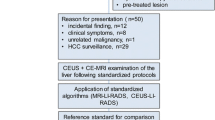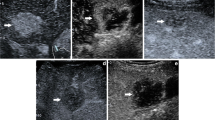Abstract
Purpose
To systematically determine the inter-reader reliability of the contrast-enhanced ultrasound (CEUS) Liver Imaging Reporting and Data System (LI-RADS), with emphasis on its major features for hepatocellular carcinoma (HCC) and LR-M (LI-RADS category M) features for non-HCC malignancy.
Methods
MEDLINE, EMBASE, and Cochrane databases were searched from January 2016 to March 2021 to identify original articles reporting the inter-reader reliability of CEUS LI-RADS. Meta-analytic pooled kappa values (κ) were calculated for major features [nonrim arterial-phase hyperenhancement (APHE), mild and late washout], LR-M features (rim APHE, early washout), and LI-RADS categorization using the DerSimonian-Laird random-effects model. Meta-regression analysis was performed to explore any causes of study heterogeneity.
Results
Twelve studies with a total of 2862 lesions were included. The meta-analytic pooled κ of nonrim APHE, mild and late washout, rim APHE, early washout, and LI-RADS categorization were 0.73 [95% confidence interval (CI), 0.67 − 0.79], 0.69 (95% CI, 0.54–0.84), 0.54 (95% CI, 0.37–0.71), 0.62 (95% CI, 0.45–0.79), and 0.75 (95% CI, 0.64–0.87), respectively. Compared with the major features, LR-M features had a lower meta-analytic pooled κ. Substantial study heterogeneity was noted in the LI-RADS categorization, and lesion size (p = 0.03) and the homogeneity in reader experience (p = 0.03) were significantly associated with study heterogeneity.
Conclusions
CEUS LI-RADS showed substantial inter-reader reliability for major features and LI-RADS categorization, but relatively lower reliability was found for LR-M features. In our opinion, the definitions of imaging features require further refinement to improve the inter-reader reliability of CEUS LI-RADS.
Graphic abstract



Similar content being viewed by others
Abbreviations
- HCC:
-
Hepatocellular carcinoma
- LI-RADS:
-
Liver Imaging Reporting and Data System
- CEUS:
-
Contrast-enhanced ultrasound
- CT:
-
Computed tomography
- MRI:
-
Magnetic resonance imaging
- APHE:
-
Arterial-phase hyperenhancement
- κ :
-
Kappa value
- CI:
-
Confidence interval
References
Marrero JA, Kulik LM, Sirlin CB, et al. (2018) Diagnosis, staging, and management of hepatocellular carcinoma: 2018 practice guidance by the American Association for the Study of Liver Diseases. Hepatology 68:723-750. https://doi.org/10.1002/hep.29913.
Mitchell DG, Bruix J, Sherman M, Sirlin CB (2015) LI-RADS (Liver Imaging Reporting and Data System): summary, discussion, and consensus of the LI-RADS Management Working Group and future directions. Hepatology 61:1056-1065. https://doi.org/10.1002/hep.27304.
Wilson SR, Lyshchik A, Piscaglia F, et al. (2018) CEUS LI-RADS: algorithm, implementation, and key differences from CT/MRI. Abdom Radiol (NY) 43:127-142. https://doi.org/10.1007/s00261-017-1250-0.
American College of Radiology (2021) CEUS LI-RADS v2017 core. https://www.acr.org/-/media/ACR/Files/RADS/LI-RADS/CEUS-LI-RADS-2017-Core.pdf. Accessed 31 March 2021.
Shin J, Lee S, Bae H, et al. (2020) Contrast-enhanced ultrasound Liver Imaging Reporting and Data System for diagnosing hepatocellular carcinoma: a meta-analysis. Liver Int 40:2345-2352. https://doi.org/10.1111/liv.14617.
Son JH, Choi SH, Kim SY, et al. (2020) Accuracy of contrast-enhanced ultrasound Liver Imaging Reporting and Data System: a systematic review and meta-analysis. Hepatol Int 14:1104-1113. https://doi.org/10.1007/s12072-020-10102-5.
Li J, Chen M, Wang ZJ, et al. (2020) Interobserver agreement for contrast-enhanced ultrasound of Liver Imaging Reporting and Data System: a systematic review and meta-analysis. World J Clin Cases 8:5589-5602. https://doi.org/10.12998/wjcc.v8.i22.5589.
Li J, Ling W, Chen S, et al. (2019) The interreader agreement and validation of contrast-enhanced ultrasound Liver Imaging Reporting and Data System. Eur J Radiol 120:108685. https://doi.org/10.1016/j.ejrad.2019.108685.
Terzi E, Iavarone M, Pompili M, et al. (2018) Contrast ultrasound LI-RADS LR-5 identifies hepatocellular carcinoma in cirrhosis in a multicenter restropective study of 1,006 nodules. J Hepatol 68:485-492. https://doi.org/10.1016/j.jhep.2017.11.007.
Kang HJ, Lee JM, Yoon JH, Han JK (2021) Role of contrast-enhanced ultrasound as a second-line diagnostic modality in noninvasive diagnostic algorithms for hepatocellular carcinoma. Korean J Radiol 22:354-365. https://doi.org/10.3348/kjr.2020.0973.
Kang HJ, Lee JM, Yoon JH, et al. (2020) Contrast-enhanced US with sulfur hexafluoride and perfluorobutane for the diagnosis of hepatocellular carcinoma in individuals with high risk. Radiology 297:108-116. https://doi.org/10.1148/radiol.2020200115.
Li W, Li L, Zhuang BW, et al. (2021) Inter-reader agreement of CEUS LI-RADS among radiologists with different levels of experience. Eur Radiol. https://doi.org/10.1007/s00330-021-07777-1.
Makoyeva A, Kim TK, Jang HJ, et al. (2020) Use of CEUS LI-RADS for the accurate diagnosis of nodules in patients at risk for hepatocellular carcinoma: a validation study. Radiol Imaging Cancer 2:e190014. https://doi.org/10.1148/rycan.2020190014.
Zhou H, Zhang C, Du L, et al. (2020) Contrast-enhanced ultrasound Liver Imaging Reporting and Data System in diagnosing hepatocellular carcinoma: diagnostic performance and interobserver agreement. Ultraschall Med. https://doi.org/10.1055/a-1168-6321.
Stroup DF, Berlin JA, Morton SC, et al. (2000) Meta-analysis of observational studies in epidemiology: a proposal for reporting. Meta-analysis Of Observational Studies in Epidemiology (MOOSE) group. JAMA 283:2008-2012. https://doi.org/10.1001/jama.283.15.2008.
Liberati A, Altman DG, Tetzlaff J, et al. (2009) The PRISMA statement for reporting systematic reviews and meta-analyses of studies that evaluate healthcare interventions: explanation and elaboration. BMJ 339:b2700. https://doi.org/10.1136/bmj.b2700.
Moher D, Liberati A, Tetzlaff J, et al. (2009) Preferred reporting items for systematic reviews and meta-analyses: the PRISMA statement. BMJ 339:b2535. https://doi.org/10.1136/bmj.b2535.
Kottner J, Audige L, Brorson S, et al. (2011) Guidelines for Reporting Reliability and Agreement Studies (GRRAS) were proposed. J Clin Epidemiol 64:96-106. https://doi.org/10.1016/j.jclinepi.2010.03.002.
IntHout J, Ioannidis JP, Borm GF (2014) The Hartung-Knapp-Sidik-Jonkman method for random effects meta-analysis is straightforward and considerably outperforms the standard DerSimonian-Laird method. BMC Med Res Methodol 14:25. https://doi.org/10.1186/1471-2288-14-25.
Landis JR, Koch GG (1977) The measurement of observer agreement for categorical data. Biometrics 33:159-174.
Higgins JP, Thompson SG, Deeks JJ, Altman DG (2003) Measuring inconsistency in meta-analyses. BMJ 327:557-560. https://doi.org/10.1136/bmj.327.7414.557.
Ling W, Wang M, Ma X, et al. (2018) The preliminary application of Liver Imaging Reporting and Data System (LI-RADS) with contrast-enhanced ultrasound (CEUS) on small hepatic nodules (</= 2cm). J Cancer 9:2946-2952. https://doi.org/10.7150/jca.25539.
Schellhaas B, Pfeifer L, Kielisch C, et al. (2018) Interobserver agreement for contrast-enhanced ultrasound (CEUS)-based standardized algorithms for the diagnosis of hepatocellular carcinoma in high-risk patients. Ultraschall Med 39:667-674. https://doi.org/10.1055/a-0612-7887.
Tan Z, Teoh WC, Wong KM, et al. (2020) Analysis of comparative performance of CEUS and CECT/MR LI-RADS classification: Can CEUS dichotomize LI-RADS indeterminate lesions on CT or MRI? Clin Imaging 62:63-68. https://doi.org/10.1016/j.clinimag.2020.02.002.
Wang JY, Feng SY, Xu JW, et al. (2020) Usefulness of the contrast-enhanced ultrasound Liver Imaging Reporting and Data System in diagnosing focal liver lesions by inexperienced radiologists. J Ultrasound Med 39:1537-1546. https://doi.org/10.1002/jum.15242.
Wang JY, Feng SY, Yi AJ, et al. (2020) Comparison of contrast-enhanced ultrasound versus contrast-enhanced magnetic resonance imaging for the diagnosis of focal liver lesions using the Liver Imaging Reporting and Data System. Ultrasound Med Biol 46:1216-1223. https://doi.org/10.1016/j.ultrasmedbio.2020.01.023.
Kang JH, Choi SH, Lee JS, et al. (2020) Interreader agreement of Liver Imaging Reporting and Data System on MRI: a systematic review and meta-analysis. J Magn Reson Imaging 52:795-804. https://doi.org/10.1002/jmri.27065.
Kang JH, Choi SH, Lee JS, et al. (2021) Inter-reader reliability of CT Liver Imaging Reporting and Data System according to imaging analysis methodology: a systematic review and meta-analysis. Eur Radiol. https://doi.org/10.1007/s00330-021-07815-y.
Schellhaas B, Hammon M, Strobel D, et al. (2018) Interobserver and intermodality agreement of standardized algorithms for non-invasive diagnosis of hepatocellular carcinoma in high-risk patients: CEUS-LI-RADS versus MRI-LI-RADS. Eur Radiol 28:4254-4264. https://doi.org/10.1007/s00330-018-5379-1.
Jang HJ, Kim TK, Burns PN, Wilson SR (2007) Enhancement patterns of hepatocellular carcinoma at contrast-enhanced US: comparison with histologic differentiation. Radiology 244:898-906. https://doi.org/10.1148/radiol.2443061520.
Grimm LJ, Anderson AL, Baker JA, et al. (2015) Interobserver variability between breast imagers using the fifth edition of the BI-RADS MRI lexicon. AJR Am J Roentgenol 204:1120–1124. https://doi.org/10.2214/ajr.14.13047.
Greer MD, Shih JH, Lay N, et al. (2019) Interreader variability of Prostate Imaging Reporting and Data System version 2 in detecting and assessing prostate cancer lesions at prostate MRI. AJR Am J Roentgenol 212:1197-1205. https://doi.org/10.2214/ajr.18.20536.
Park KJ, Choi SH, Lee JS, et al. (2020) Interreader agreement with Prostate Imaging Reporting and Data System version 2 for prostate cancer detection: a systematic review and meta-analysis. J Urol 204:661-670. https://doi.org/10.1097/ju.0000000000001200.
Bartolotta TV, Taibbi A, Midiri M, Lagalla R (2019) Contrast-enhanced ultrasound of hepatocellular carcinoma: where do we stand? Ultrasonography 38:200-214. https://doi.org/10.14366/usg.18060.
Stevens WR, Gulino SP, Batts KP, et al. (1996) Mosaic pattern of hepatocellular carcinoma: histologic basis for a characteristic CT appearance. J Comput Assist Tomogr 20:337-342. https://doi.org/10.1097/00004728-199605000-00001.
Funding
The authors state that this work has not received any funding.
Author information
Authors and Affiliations
Corresponding author
Ethics declarations
Conflict of interest
All authors declare that they have no conflict of interest.
Ethical approval
Institutional review board approval and written informed consent is not required because this study is a meta-analysis based on previously published studies.
Additional information
Publisher's Note
Springer Nature remains neutral with regard to jurisdictional claims in published maps and institutional affiliations.
Supplementary Information
Below is the link to the electronic supplementary material.
Rights and permissions
About this article
Cite this article
Kang, J.H., Choi, S.H., Lee, J.S. et al. Inter-reader reliability of contrast-enhanced ultrasound Liver Imaging Reporting and Data System: a meta-analysis. Abdom Radiol 46, 4671–4681 (2021). https://doi.org/10.1007/s00261-021-03169-7
Received:
Revised:
Accepted:
Published:
Issue Date:
DOI: https://doi.org/10.1007/s00261-021-03169-7




